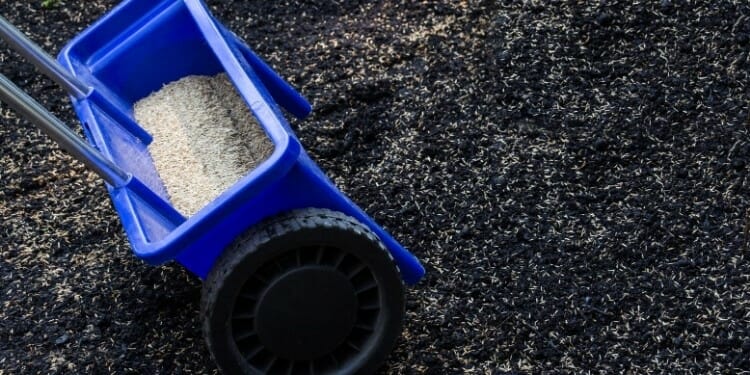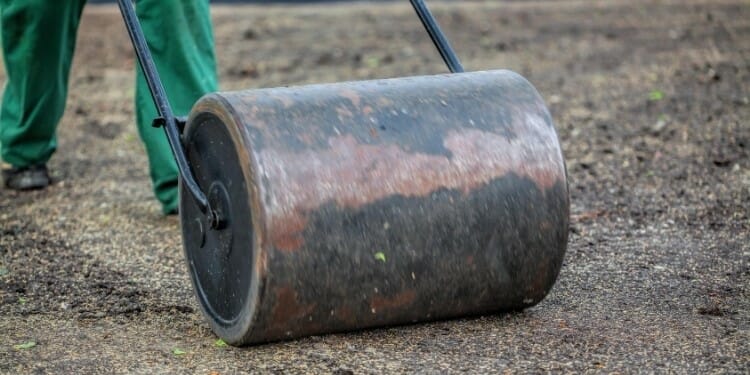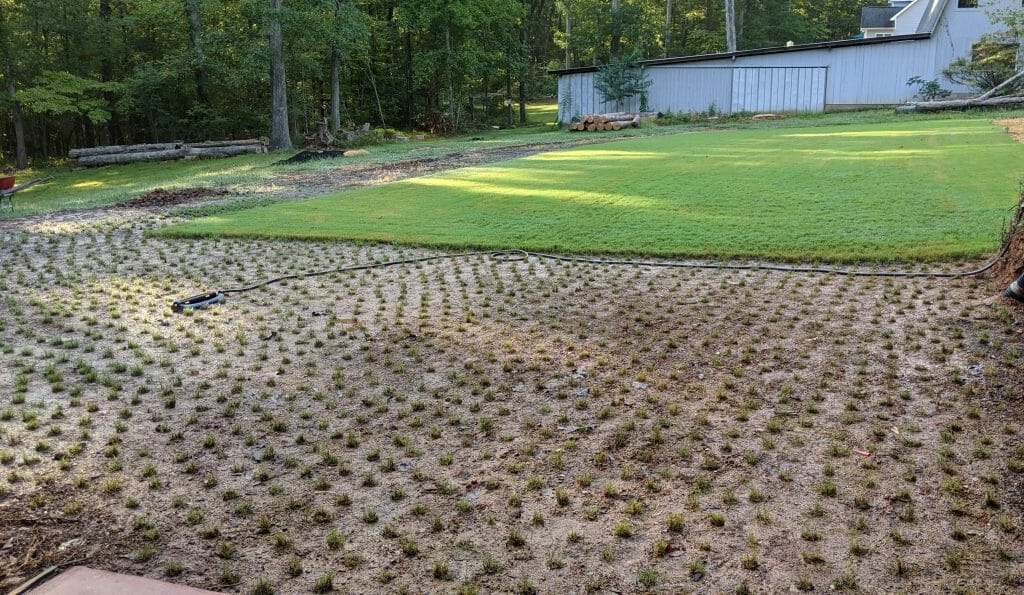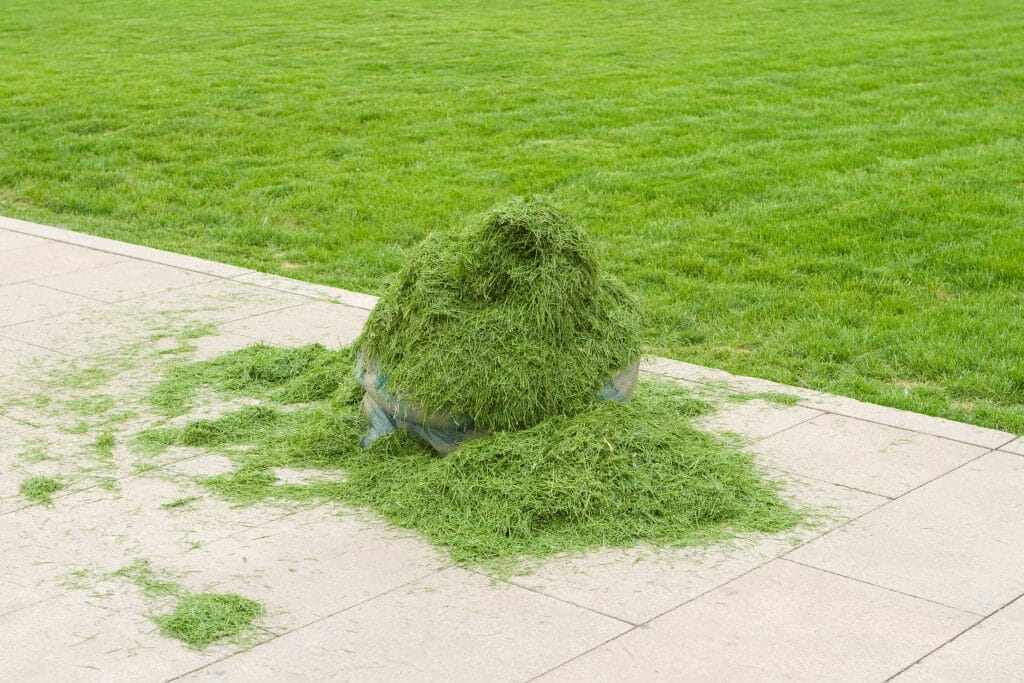A common question that we get asked is “will grass seed germinate on the surface of the soil?” The simple answer to this is yes. In fact, it’s important not to bury your seed because the young grass shoots cannot break through if there is too much soil on top of them.
However, how well your seeds germinate depends on how you’ve prepared the ground. So, let’s look at the best practices for seeding a new lawn.
Seeding On Top of Soil: Step-by-Step
Prepare Your Ground
There are certain steps that you need to take to ensure that you give your little grass seedlings the best start in life.
1. Get Rid of Any Weeds
You don’t want your new grass competing for food and water with weeds. Therefore, make sure that you remove any weeds in the ground, either by pulling them out manually or using a broad-spectrum herbicide.
2. Loosen the Topsoil
Next you want to loosen up the topsoil to create little pockets for the new rooted seedling to grow into. There’s no need to turn the soil over. You just want to make it friable.
You can do this easily with a digging fork if you only have a small area to seed. For larger or harder areas, you might need to hire an aerator to run over the soil.
3. Fill any Dips or Holes with Sand
If your ground is very uneven and has lots of dips and holes, it’s worth filling these with some sand mixed in with some topsoil. This will give you a nice even lawn to mow when the time comes.
4. Test Your Soil
This is the perfect time to test both the nutrients and pH of your soil. Grass tends to prefer a slightly acidic soil within a pH range of 6.2 – 7. You can purchase kits to do this yourself or call in a professional.
5. Amend the pH of the Soil if Necessary
Once you get your soil test results back, you can amend the pH of your soil if necessary. If your soil is slightly alkaline, try adding wood ash or lime. On the other hand, if your soil is highly acidic, you can add sulphur or organic material such as a good compost to lower the pH.
6. Add a Starter Fertilizer to your Soil
Choose a suitable starter fertilizer with the required levels of nitrogen, phosphorous and potassium and spread it over the ground. It’s also a good idea to lightly water in the fertilizer but avoid overwatering.
Once all this is done, your patch of ground is now ready for planting your seeds.
How to Seed your New Lawn
Firstly, you’ll want to select the correct grass seed for your climate. You can either choose a single grass variety or better still, get a mix of grasses ideally suited to where you live. You can even buy a mixture of grass seed, mulch and fertilizer if it’s within your budget. If you do this, you can skip step 6 above.
Depending on how large your area is, there are several ways you can broadcast the seeds.
You can either scatter them by hand if you have a very small area or use a seeder for larger areas. There are a variety of seeders available on the market. These include:
- A hand cranked seeder which you carry along as you walk across the ground.
- Chest mounted seeders
- Push along seeders which distribute the seed evenly as you walk over the ground.
As a general rule of thumb, you want to scatter about 15-20 seeds over every square inch of ground to give you enough coverage. While you’re broadcasting your seed, make sure to overlap as you walk along so that you don’t have any bare patches.
MUST READ: When does grass stop growing?
Ensuring Your Seeds Have Good Soil Contact
For your seeds to grow effectively, you need to ensure that they are in contact with the soil. This allows the first root (radicle) to penetrate into the ground and establish itself. If this does not happen quickly enough and the seed just stays above the soil, the radicle may die.
There are a couple of ways you can ensure good seed-soil contact. You can either rake the ground lightly to mix the seed with the soil or you can use an empty roller to run over the ground. This will effectively push the seed into contact with the soil.
Now It’s Time To Add Some Water
All seeds need moisture to grow, so you need to ensure that you don’t let your little seedlings dry out. The top soil should be moist at all times. If you allow your seedlings to dry out, they’ll die.
However, you want to be careful that you don’t wash the seeds away as you water. Therefore, it’s best to lightly water with a hose with a mister attachment. This will give the soil enough moisture without disturbing the seeds.
Make sure that you check your soil daily to keep it moist. You might need to do this both morning and night. Different grass seeds germinate at different rates. Your seeds could take from 7 to 28 days to fully germinate, so you need to keep up the misting for this period of time.
But don’t worry, this is probably the most intense care that you’ll ever have to lavish on your lawn.
Keep Off The Grass
It goes without saying that you should keep all traffic off your newly seeded lawn area. This includes children and dogs. Ideally, try and rope off the area if you can and make everyone aware that they should not walk on it.
Frequently Asked Questions:
How long does it take for grass seeds to germinate?
This depends on the grass variety but grass seed germination can be anywhere from 7 to 28 days. In colder weather it could even take longer.
Should I soak grass seeds before planting?
You can soak your grass seeds to pre-germinate them, but generally, this is not necessary. Just follow the directions for the seed variety that you’ve chosen.
What triggers grass seeds to germinate?
Seeds will start to germinate when they’ve absorbed enough moisture. This is why soaking the seed will speed up the process. Warm soil temperatures and adequate light will also speed up the germination process.
Final Thoughts
So now that we’ve answered the question of whether grass seed will germinate on the surface of the soil, you’re adequately armed with enough information to start seeding your new lawn.








